Adobe, << uh DOH bee, >> is the Spanish name for sun-dried bricks, or for a house built with such bricks. A less common type of adobe is made with dampened earth pressed down in building forms similar to those used for poured concrete walks.

People have used adobe to build houses and other structures in desert regions for thousands of years. The ancient Egyptians and Babylonians used adobe.
To make adobe, workers mix sandy clay or loam (a mixture of sand, clay, and silt) with water and a small quantity of straw, grass, or similar material. The straw holds the mixture together, giving the bricks greater stability. The mixture is placed in wooden forms that shape it into bricks. Workers remove the forms when the bricks are dry. Then they bake the bricks in the heat of the sun for several days or weeks.
Adobe houses are common in Mexico and the southwestern part of the United States. Traditional adobe houses are covered with mud. Modern adobe houses are covered with a plasterlike material called stucco. Adobe houses are cooler than uninsulated homes made of wood or stone, but adobe is not suitable for use in cold or damp regions. The bricks will crumble if they are exposed to rain or to periods of freezing temperatures followed by thaws.
